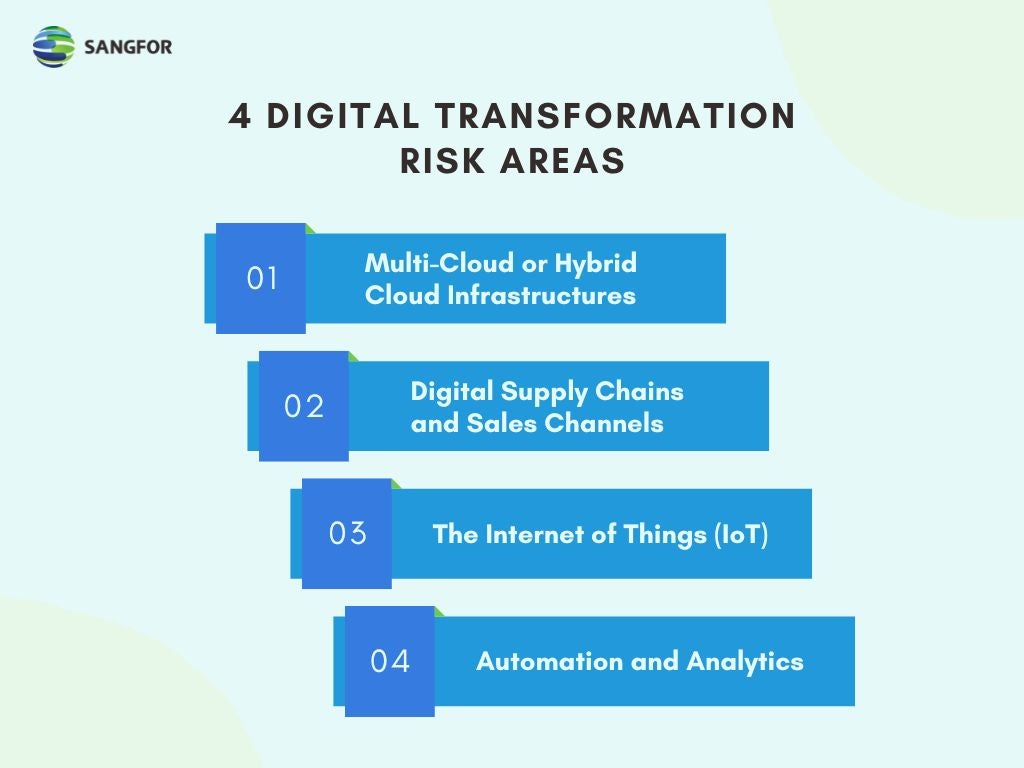Innovative technologies are the cornerstone of building a better future in the modern age. Each day, companies invest in enhanced platforms to optimize their workflows, automate tasks, and keep up with the rush to digital transformation. However, certain risks and challenges follow such a radical shift for any company. In this blog article, we take a closer look at digital transformation risks and how to manage them effectively. We also focus on the security and infrastructure needed to mitigate digital transformation risks and challenges.

Digital transformation can be described as a move towards elevated and advanced technologies, infrastructure, and systems. This is usually done to keep up with growing demands in a digitally dynamic landscape when traditional means simply don’t cut it anymore. With digital transformation, companies can enjoy efficient, automated, and reliable systems. However, there are several risks associated with digital transformation as well that need to be addressed to fully optimize a digitally transformed setup. As businesses become more digitally advanced, they also become interconnected and more vulnerable in specific areas. Now, let’s look at the main digital transformation risk areas to better understand the concept.
What Are Digital Transformation Risk Areas?
Managing risk in digital transformation is key to realizing your company’s true potential. To do that effectively, you need to understand the main areas of risk when dealing with digital transformation. Generally, these areas can be categorized into 4 groups:

1. Multi-Cloud or Hybrid Cloud Infrastructures
The cloud has been massively popular for many years now and most organizations already use multi-cloud or hybrid cloud setups to achieve a level of agility and flexibility for their data. While cloud adoption is a positive feature of digital transformation, it also presents a significant vulnerability. Digital transformation risks associated with multicloud or hybrid cloud infrastructure include:
- Misconfigurations
- Lack of visibility
- Data loss
- Inadequate privacy regulations
- Lack of vendor stability
- Lack of an incident response plan
While the cloud offers a practical solution, it needs to be secured and managed effectively to not be a vulnerability. Sangfor’s Managed Cloud Services offer a series of cloud infrastructure options that can be customized to your business and provide security and flexibility from a secure front.
2. Digital Supply Chains and Sales Channels
For most companies, the shift to digital supply chains and sales channels can streamline processes, cut down on errors, and be more cost-effective. However, without a clear multichannel strategy, your business can suffer disruptions and become vulnerable to cybersecurity risks.
3. The Internet of Things (IoT)
Another major digital transformation risk area is the vulnerability of Internet of Things devices. While expanding your network to digitally transform, the IoT is useful in forming the connective frame between devices to correlate and process data at multiple points. However, this also opens up a wider attack surface for cyber-attacks and data breaches.
4. Automation and Analytics
The last risk area we have to deal with explores the analysis and storage of data. Using poor datasets or inadequate platforms to process and analyze data will lead to flawed performances. With such large amounts of data being processed each second, companies can use AI frameworks or advanced analytics features to comb through their data – ensuring streamlined analytics that are accurate and more efficient.
While these are the main areas of digital transformation risk, companies will also need to apply specific attention to the key digital transformation security risks to minimize damage and keep operations optimized. Next, we’ll go over some of these key digital transformation risks in more detail.
Key Digital Transformation Risks
For companies to implement effective advanced technologies and techniques, they need to identify and understand the most common risks associated with digital transformation. These are some of the main digital transformation risks that can be encountered:
- Increased Attack Surfaces: With an expanded digital network, companies will ultimately be expanding the attack surface for cyber-criminals. Using more devices and complex infrastructure widens the target for cyber-attacks. The Internet of Things is a main contributor to this increased attack surface by ensuring a connected network across several devices that can be easily infiltrated and exploited. This seamless connectivity might streamline operations, but companies need to understand the significant risks that an open network presents as well.
- Resistance to Change: Most employees might be hesitant to adopt new technologies that might seem too complex or difficult to operate and understand. Introducing new platforms without adequate training and information will cause disruptions, errors, and employee resistance.
- Insider Threats: The human element is often the cause of most technological disruptions. With intentional or unintentional access breaches, a company is put in a vulnerable state. With a digitally advanced infrastructure, access controls need to be strict and constantly monitored for any anomalies to avoid insider threats.
- AI Integration: Artificial Intelligence is an innovative technology that is used widely in digital transformative platforms. The automated and seamless technology ensures streamlined operations and reduces manual work. However, AI can also be inaccurate at times and is often criticized for taking away the roles of human employees – producing “lifeless” content for the sake of productivity. Companies need to use AI carefully to ensure optimal operation and security processes while reducing risk.
- Talent Shortage: To effectively implement a digital transformation for your company, you need the right skills to operate and maintain your new infrastructure. This means that companies need to hire specialized teams to run their advanced platforms or invest in effective training for existing employees. Unfortunately, the IT sector has also been struggling with a shortage of skilled professionals in the last few years.
These are all relevant risks that need to be considered when undertaking a digital transformation for any business. Now, we can look at the wider scope and explore the main challenges of digital transformation.
Challenges of Digital Transformation
Surviving a digitally dynamic and evolving landscape can be difficult for any business. Digital transformation can be difficult and the transition will naturally be met with some hurdles. To properly understand the risks involved, we’ve listed some of the main challenges of digital transformation:
- Integrating Legacy Systems: In the process of digital transformation, integrating newer technologies into existing systems can be difficult. These legacy systems lack the flexibility and speed that modern platforms often need to function. While agility is crucial in implementing transformative digital systems, it’s simply not a feasible option for most companies to simply uproot their entire legacy infrastructure without significant disruptions. To avoid these challenges, companies need to invest in vendors that offer seamless transitions or collaborative platforms that are easy to operate and integrate into existing systems.
- Lack of Direction: Without a well-defined plan for your company’s digital transformation, the process can come to a quick halt when employees and stakeholders are not on the same page. Companies need to enact effective change management processes to collaborate effectively with the right support, understanding, and information. A lack of direction and leadership will ensure that your digital transformation is met with disjointed implementation and siloed decision-making.
- Data Security Concerns: When companies rush to digitize operations, data security often takes the back seat in terms of concerns. Unfortunately, this can have devastating effects. Data safety is an integral part of your company’s digital transformation process. Your data needs to remain secure, encrypted, and monitored throughout the implementation process. Digital transformation can leave blind spots and security gaps that can be exploited by hackers. This can lead to regulatory non-compliance, legal consequences, and hefty penalties from data protection organizations.
- Budget Constraints: The infrastructure, expertise, software, and maintenance of a digitally advanced setup can be a costly affair for any organization. Companies need to remain realistic about their budget and their expected ROI from their digital transformation.
- Lack of Training and Awareness: To effectively implement a digital transformation, your workforce needs to be adequately trained to operate and maintain complex digital platforms. Companies need to provide training and education to ensure that all parties know what strategies and plans should be put into effect under which circumstances.
These challenges to digital transformation can be easily overcome with the right tools and effort from leadership roles. Next, we’ll look at some of the real-life examples of digital transformation risks.
Real-Life Examples of Digital Transformation Risks
While digital transformation has countless benefits in the real world, it’s integral to see the full scale of the concept to implement it effectively and safely. To fully understand the risks of digital transformation, we’re now going to explore some of the real-life examples:
Cybersecurity Risks
One of the leading concerns after digital transformation is the risk of cyber-attacks increasing.
Colonial Pipeline, the largest oil product pipeline operator in the United States, was forced to shut down all of its operations in 2021 after a ransomware attack by the Darkside hacking group. Similarly, in 2023, the CL0P ransomware group began exploiting a previously unknown SQL injection vulnerability in the file-transferring software, MOVEit Transfer. The attack affected several large companies who used the service including BBC, British Airways, and Ofcom.

Operational Disruptions
In 2023, British Airways experienced an IT glitch in its system that caused 175 flight cancellations and affected over 20,000 passengers.
Data Security Concerns
The MediSecure healthcare technology company was recently the victim of a data breach that left patient data vulnerable. Likewise, in April 2017, Scottrade Bank experienced a data breach that exposed the personal information of 20,000 of its customers because a third-party vendor uploaded a file to a server without adequate cybersecurity protections.
AI and Algorithmic Risks
The rise of AI cyber-attacks has been a growing concern as the technology steadily rose to mainstream use and began making rounds in the hands of hackers who used automated and efficient capabilities to generate, spread, and supplement malware. ABC also reported that AI suffers from discriminatory bias with biometric identification systems that disproportionately misidentify the faces of Black people and minorities, to applications of voice recognition software that fail to distinguish voices with distinct regional accents.
Advanced Persistent Threats
In 2015, the Carbanak hacking group targeted global banks with APT attacks that led to stealing over US$ 1.2 billion from more than 100 banks in 40 countries.
Supply Chain Risks
Supply chains are popular targets for hackers who want to disrupt operations majorly. Supply chain attacks are a glaring vulnerability that can have devastating effects on entire economies. In 2022, car giant Toyota was hit by a cyber-attack that forced it to close all its factories in Japan for an entire day. More than 13,000 vehicles were not produced because of the closures.
In 2023, the Nagoya Port - the largest in Japan - was also hit by an attack that disrupted container operations across all terminals within the port.
Cloud Provider Risks
In 2017, Amazon experienced a 4-hour outage at its AWS cloud computing division.
The risks associated with digital transformation can seem daunting for many companies looking to update their infrastructure. However, it’s important to note that these risks can be easily mitigated with the right tools and support. Let’s take a further look into how these risks can be avoided next.
How to Mitigate Digital Transformation Risks
For a company on the brink of digital transformation, it might seem exciting to implement new technologies and systems. These innovative platforms come with risks and challenges of their own, however, and it’s crucial to be prepared to deal with them. These are some ways that businesses can mitigate the risks of digital transformation:
- Being realistic with expectations: Try to engage with your long-term goals for the business on a realistic level. While the general hope is that digital transformation will improve productivity and profits, companies need to maintain a realistic idea of their ROI – especially in the initial phase of digital transformation.
- Maintaining leadership support: Your workforce is only as dedicated as you are. Try to stay motivated and support your employees in the process of digital transformation to reassure them of the company’s goals, direction, and leading concerns.
- Be transparent: Clarity is essential within your company to mitigate the risks of digital transformation. Sharing information, processing feedback, and actively evaluating progress with your team will reassure them and provide a stable foundation for problem-solving.
- Providing training and awareness: Investing in digital transformation means investing in the skills of your workforce to maintain that infrastructure as well. Offer training programs to ensure that your staff is equipped with the necessary skills to adapt to the digital age.
Mitigating digital transformation risks can be a tedious task for a business. Fortunately, there are ways that each business can protect themselves from these risks without too much strain. Next, we’ll touch on the main tips to keep your business safe from digital transformation risks.
How Businesses Can Protect Themselves from Digital Transformation Risks
For any business starting its digital transformation, the process can be worrying. With so much that could potentially go wrong, it’s difficult to keep a straight head. To make this process less scary, we’ve listed some tips to help with managing risk in digital transformation.
- Identifying Cybersecurity Risks: This is a crucial step to fully protect yourself. You need to know exactly how your digital transformation for your specific business might backfire or be flawed. This can help you to build proactive strategies and plans for the future.
- Ensure Limited Access Controls: Your digital infrastructure may have several loopholes and gaps that unauthorized access can get through. Try to make access control a priority to prevent data breaches, insider threats, and vulnerabilities.
- Creating a Comprehensive Incident Response Plan: An effective incident response plan will make sure that your team can respond immediately to a threat or security event. This significantly reduces the damage done and ensures that recovery is swift.
- Using Network Segmentation: In a network of connected devices and systems, isolating critical data is key to protecting it. Segmenting your network will ensure that access controls are maintained and that any potential attack has limited lateral movement across the entire network.
- Securing IoT Devices: Be sure to regularly update software and change passwords on all connected devices. This reduces the chance of these devices being exploited by hackers who want to gain access to the network.
- Invest in Reliable Cloud and Cybersecurity Vendors: Your infrastructure and security platforms need to come from a vendor that understands the risks of digital transformation. Sangfor Technologies provides a comprehensive list of services and platforms that protect and manage your digital transformation in the most secure, efficient, and affordable way.
For cloud infrastructure that understands your needs, Sangfor’s Hyper-Converged Infrastructure solution is ideal. The innovative 3rd-generation platform converges computing, storage, networking, and security on a single software-defined stack to provide a simplified 1-stop software-defined data center solution tailored for all your business-critical applications.
Seamlessly protect your endpoints from security breaches with Sangfor Endpoint Secure which is designed to defend systems from malware and APT threats with a holistic response and an approach different from NGAV and EDR solutions. This platform combats infections across your entire organizational network. Whether you need on-premises management, cloud management, or hybrid solutions, Sangfor Endpoint Secure is also entirely scalable to meet your business needs.
Go a step further with your cybersecurity and make use of AI that works with Sangfor’s Cyber Command platform that uses artificial intelligence to easily identify threats and then hunt them down. Through a completely transparent process, businesses can get a better understanding of how the attack took place so they can reinforce their security for the future. Cyber Command integrates a variety of network and endpoint protection measures to respond to threats in a simple, effective, and automated manner.
For businesses to overcome the digital transformation risks most optimally, they need to understand the specific risks involved, their effects, and how to mitigate them. Businesses can implement their digital transformation in an informed, secure, and streamlined way by using the tools and products provided by Sangfor for innovation that you can count on. Contact Sangfor today for any queries or visit www.sangfor.com for more information.
Pople Also Ask
Risks that might affect a digital workplace include:
- Cybersecurity
- Resistance to change
- Compliance issues
- Cloud complexity
- Automation and AI irregularities
- Privacy and data security concerns
The negative effects of digitalization include:
- Data vulnerability
- Privacy issues
- Expensive maintenance and operations
- Complexity of operations
- Needing to upskill workers
- Over-reliance on technology
Businesses that turn to digital transformation have streamlined operations, higher revenue, elevated workflows, and a competitive edge.
Digital transformation can be risky when companies invest in inadequate infrastructure or cybersecurity – creating vulnerabilities that can be exploited in cyber-attacks and data breaches.
Businesses can avoid digital transformation risks by:
- Limiting access controls
- Staying informed
- Providing awareness and training
- Investing in advanced cloud and cybersecurity infrastructure
- Securing IoT devices





